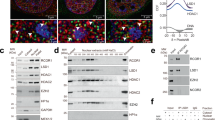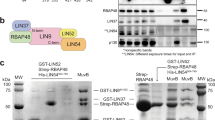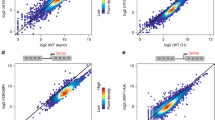Abstract
Recruitment of the histone deacetylase (HDAC)-associated Sin3 corepressor is an obligatory step in many eukaryotic gene silencing pathways. Here we show that HBP1, a cell cycle inhibitor and regulator of differentiation, represses transcription in a HDAC/Sin3-dependent manner by targeting the mammalian Sin3A (mSin3A) PAH2 domain. HBP1 is unrelated to the Mad1 repressor for which high-resolution structures in complex with PAH2 have been described. We show that like Mad1, the HBP1 transrepression domain binds through a helical structure to the hydrophobic cleft of mSin3A PAH2. Notably, the HBP1 helix binds PAH2 in a reversed orientation relative to Mad1 and, equally unexpectedly, this is correlated with a chain reversal of the minimal Sin3 interaction motifs. These results not only provide insights into how multiple, unrelated transcription factors recruit the same coregulator, but also have implications for how sequence similarity searches are conducted.
This is a preview of subscription content, access via your institution
Access options
Subscribe to this journal
Receive 12 print issues and online access
$189.00 per year
only $15.75 per issue
Buy this article
- Purchase on Springer Link
- Instant access to full article PDF
Prices may be subject to local taxes which are calculated during checkout






Similar content being viewed by others
References
Elgin, S.C.R. & Workman, J.L. Chromatin Structure and Gene Expression 328 (Oxford Univ. Press, New York, 2000).
Ptashne, M. & Gann, A. Genes and Signals 192 (Cold Spring Harbor Laboratory Press, Cold Spring Harbor, New York, 2002).
Burke, L.J. & Baniahmad, A. Co-repressors 2000. FASEB J. 14, 1876–1888 (2000).
Chan, H.M. & La Thangue, N.B. p300/CBP proteins: HATs for transcriptional bridges and scaffolds. J. Cell Sci. 114, 2363–2373 (2001).
Knoepfler, P.S. & Eisenman, R.N. Sin meets NuRD and other tails of repression. Cell 99, 447–450 (1999).
Ayer, D.E., Lawrence, Q.A. & Eisenman, R.N. Mad-Max transcriptional repression is mediated by ternary complex formation with mammalian homologs of yeast repressor Sin3. Cell 80, 767–776 (1995).
Schreiber-Agus, N. et al. An amino-terminal domain of Mxi1 mediates anti-Myc oncogenic activity and interacts with a homolog of the yeast transcriptional repressor SIN3. Cell 80, 777–786 (1995).
Hurlin, P.J., Queva, C. & Eisenman, R.N. Mnt: a novel Max-interacting protein and Myc antagonist. Curr. Top. Microbiol. Immunol. 224, 115–121 (1997).
David, G. et al. Histone deacetylase associated with mSin3A mediates repression by the acute promyelocytic leukemia-associated PLZF protein. Oncogene 16, 2549–2556 (1998).
Jones, P.L. et al. Methylated DNA and MeCP2 recruit histone deacetylase to repress transcription. Nat. Genet. 19, 187–191 (1998).
Nan, X. et al. Transcriptional repression by the methyl-CpG-binding protein MeCP2 involves a histone deacetylase complex. Nature 393, 386–389 (1998).
Murphy, M. et al. Transcriptional repression by wild-type p53 utilizes histone deacetylases, mediated by interaction with mSin3a. Genes Dev. 13, 2490–2501 (1999).
Koipally, J., Renold, A., Kim, J. & Georgopoulos, K. Repression by Ikaros and Aiolos is mediated through histone deacetylase complexes. EMBO J. 18, 3090–3100 (1999).
Grimes, J.A. et al. The co-repressor mSin3A is a functional component of the REST-CoREST repressor complex. J. Biol. Chem. 275, 9461–9467 (2000).
Naruse, Y., Aoki, T., Kojima, T. & Mori, N. Neural restrictive silencer factor recruits mSin3 and histone deacetylase complex to repress neuron-specific target genes. Proc. Natl. Acad. Sci. USA 96, 13691–13696 (1999).
Yang, Q. et al. The winged-helix/forkhead protein myocyte nuclear factor beta (MNF-β) forms a co-repressor complex with mammalian sin3B. Biochem. J. 345, 335–343 (2000).
Zhang, J.S. et al. A conserved α-helical motif mediates the interaction of Sp1-like transcriptional repressors with the corepressor mSin3A. Mol. Cell. Biol. 21, 5041–5049 (2001).
Wotton, D., Knoepfler, P.S., Laherty, C.D., Eisenman, R.N. & Massague, J. The Smad transcriptional corepressor TGIF recruits mSin3. Cell Growth Diff. 12, 457–463 (2001).
Washburn, B.K. & Esposito, R.E. Identification of the Sin3-binding site in Ume6 defines a two-step process for conversion of Ume6 from a transcriptional repressor to an activator in yeast. Mol. Cell. Biol. 21, 2057–2069 (2001).
Ahringer, J. NuRD and SIN3 histone deacetylase complexes in development. Trends Genet. 16, 351–356 (2000).
Ayer, D.E. Histone deacetylases: transcriptional repression with SINers and NuRDs. Trends Cell Biol. 9, 193–198 (1999).
Ng, H.H. & Bird, A. Histone deacetylases: silencers for hire. Trends Biochem. Sci. 25, 121–126 (2000).
Brubaker, K. et al. Solution structure of the interacting domains of the Mad-Sin3 complex: implications for recruitment of a chromatin-modifying complex. Cell 103, 655–665 (2000).
Spronk, C.A. et al. The Mad1-Sin3B interaction involves a novel helical fold. Nat. Struct. Biol. 7, 1100–1104 (2000).
van Ingen, H. et al. Extension of the binding motif of the Sin3 interacting domain of the Mad family proteins. Biochemistry 43, 46–54 (2004).
Lavender, P., Vandel, L., Bannister, A.J. & Kouzarides, T. The HMG-box transcription factor HBP1 is targeted by the pocket proteins and E1A. Oncogene 14, 2721–2728 (1997).
Tevosian, S.G. et al. HBP1: a HMG box transcriptional repressor that is targeted by the retinoblastoma family. Genes Dev. 11, 383–396 (1997).
Yochum, G.S. & Ayer, D.E. Pf1, a novel PHD zinc finger protein that links the TLE corepressor to the mSin3A-histone deacetylase complex. Mol. Cell. Biol. 21, 4110–4118 (2001).
Laherty, C.D. et al. Histone deacetylases associated with the mSin3 corepressor mediate Mad transcriptional repression. Cell 89, 349–356 (1997).
Ayer, D.E. & Eisenman, R.N. A switch from Myc:Max to Mad:Max heterocomplexes accompanies monocyte/macrophage differentiation. Genes Dev 7, 2110–2119 (1993).
Blackwood, E.M., Luscher, B. & Eisenman, R.N. Myc and Max associate in vivo. Genes Dev 6, 71–80 (1992).
Shih, H.H., Tevosian, S.G. & Yee, A.S. Regulation of differentiation by HBP1, a target of the retinoblastoma protein. Mol. Cell. Biol. 18, 4732–4743 (1998).
Kadosh, D. & Struhl, K. Repression by Ume6 involves recruitment of a complex containing Sin3 corepressor and Rpd3 histone deacetylase to target promoters. Cell 89, 365–371 (1997).
Linge, J.P., Habeck, M., Rieping, W. & Nilges, M. ARIA: automated NOE assignment and NMR structure calculation. Bioinformatics 19, 315–316 (2003).
Cowley, S.M. et al. Functional analysis of the Mad1-mSin3A repressor-corepressor interaction reveals determinants of specificity, affinity, and transcriptional response. Mol. Cell. Biol. 24, 2698–2709 (2004).
Gartel, A.L. et al. Activation and repression of p21(WAF1/CIP1) transcription by Rb binding proteins. Oncogene 17, 3463–3469 (1998).
Sampson, E.M. et al. Negative regulation of the Wnt-β-catenin pathway by the transcriptional repressor HBP1. EMBO J. 20, 4500–4511 (2001).
Brehm, A. et al. Retinoblastoma protein recruits histone deacetylase to repress transcription. Nature 391, 597–601 (1998).
Pang, Y.P., Kumar, G.A., Zhang, J.S. & Urrutia, R. Differential binding of Sin3 interacting repressor domains to the PAH2 domain of Sin3A. FEBS Lett. 548, 108–112 (2003).
Berk, A.J. Activation of RNA polymerase II transcription. Curr. Opin. Cell Biol. 11, 330–335 (1999).
Xu, H.E. et al. Structural determinants of ligand binding selectivity between the peroxisome proliferator-activated receptors. Proc. Natl. Acad. Sci. USA 98, 13919–13924 (2001).
Xu, H.E. et al. Structural basis for antagonist-mediated recruitment of nuclear co- repressors by PPARα. Nature 415, 813–817 (2002).
Hoeflich, K.P. & Ikura, M. Calmodulin in action: diversity in target recognition and activation mechanisms. Cell 108, 739–742 (2002).
Kuriyan, J. & Cowburn, D. Modular peptide recognition domains in eukaryotic signaling. Annu. Rev. Biophys. Biomol. Struct. 26, 259–288 (1997).
Laherty, C.D. et al. SAP30, a component of the mSin3 corepressor complex involved in N-CoR-mediated repression by specific transcription factors. Mol. Cell 2, 33–42 (1998).
Gill, S.C. & von Hippel, P.H. Calculation of protein extinction coefficients from amino acid sequence data. Anal. Biochem. 182, 319–326 (1989).
Brünger, A.T. et al. Crystallography & NMR system: a new software suite for macromolecular structure determination. Acta. Crystallogr. D 54, 905–921 (1998).
Cornilescu, G., Delaglio, F. & Bax, A. Protein backbone angle restraints from searching a database for chemical shift and sequence homology. J. Biomol. NMR 13, 289–302 (1999).
Laskowski, R.A., Rullman, J.A., MacArthur, M.W., Kaptein, R. & Thornton, J.M. AQUA and PROCHECK-NMR: programs for checking the quality of protein structures solved by NMR. J. Biomol. NMR 8, 477–486 (1996).
McDonald, I.K. & Thornton, J.M. Satisfying hydrogen bonding potential in proteins. J. Mol. Biol. 238, 777–793 (1994).
Sanner, M.F., Olson, A.J. & Spehner, J.C. Reduced surface: an efficient way to compute molecular surfaces. Biopolymers 38, 305–320 (1996).
Carson, M. Ribbons. In Macromolecular Crystallography 277, 493–505 (Academic, San Diego, 1997).
Nicholls, A., Sharp, K.A. & Honig, B. Protein folding and association: insights from the interfacial and thermodynamic properties of hydrocarbons. Proteins 11, 281–296 (1991).
Acknowledgements
We thank M. Adams for assistance with pull-down assays. This work was supported by funds from the March of Dimes Birth Defects Foundation (no. 5-FY00-605) and the US National Institutes of Health (NIH) (GM 64715) to I.R. and by funds from the NIH (CA 57138) and an American Cancer Society research professorship to R.N.E. K.A.S. was supported by an NIH molecular biophysics training grant and P.S.K. is a special fellow of the Leukemia and Lymphoma Society. We are grateful to the Lurie Comprehensive Cancer Center for supporting structural biology research at Northwestern and the Keck Biophysics Facility for access to instrumentation.
Author information
Authors and Affiliations
Corresponding authors
Ethics declarations
Competing interests
The authors declare no competing financial interests.
Supplementary information
Supplementary Fig. 1
ITC binding isotherms resulting from titrations of mSin3A PAH2 with HBP1 SID peptide (residues 358–380). (PDF 29 kb)
Supplementary Fig. 2
Primary and secondary NMR data establishing a helical conformation for HBP1 SID and the mode of interaction with the mSin3A PAH2 domain. (PDF 263 kb)
Supplementary Fig. 3
Primary and secondary NMR data establishing a helical conformation for Mad1 SID and the mode of interaction with the mSin3A PAH2 domain. (PDF 144 kb)
Rights and permissions
About this article
Cite this article
Swanson, K., Knoepfler, P., Huang, K. et al. HBP1 and Mad1 repressors bind the Sin3 corepressor PAH2 domain with opposite helical orientations. Nat Struct Mol Biol 11, 738–746 (2004). https://doi.org/10.1038/nsmb798
Received:
Accepted:
Published:
Issue Date:
DOI: https://doi.org/10.1038/nsmb798
This article is cited by
-
Connecting the αα-hubs: same fold, disordered ligands, new functions
Cell Communication and Signaling (2021)
-
The HMG box transcription factor HBP1: a cell cycle inhibitor at the crossroads of cancer signaling pathways
Cellular and Molecular Life Sciences (2019)
-
Sin3A recruits Tet1 to the PAH1 domain via a highly conserved Sin3-Interaction Domain
Scientific Reports (2018)
-
Novel Genomic and Evolutionary Insight of WRKY Transcription Factors in Plant Lineage
Scientific Reports (2016)
-
The functional interactome landscape of the human histone deacetylase family
Molecular Systems Biology (2013)



